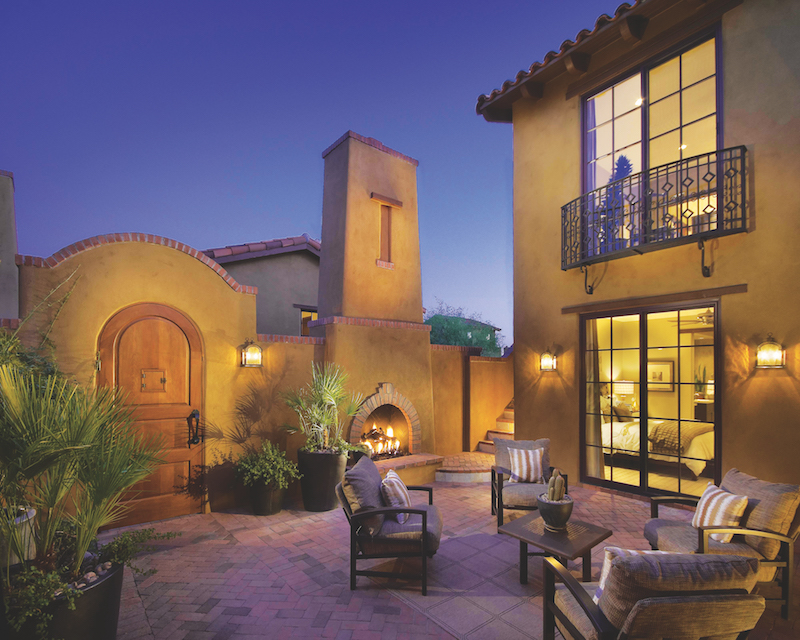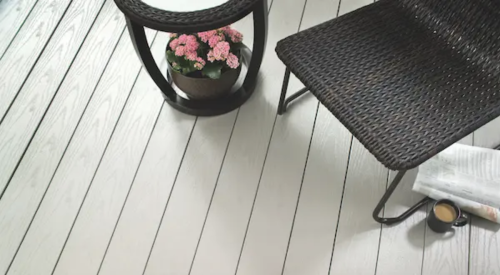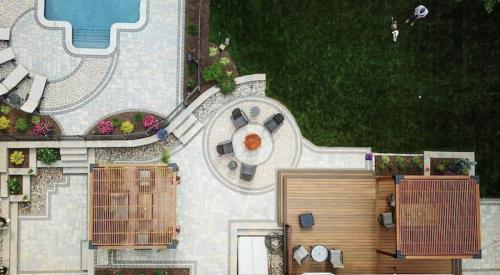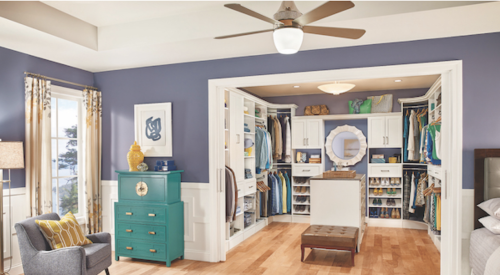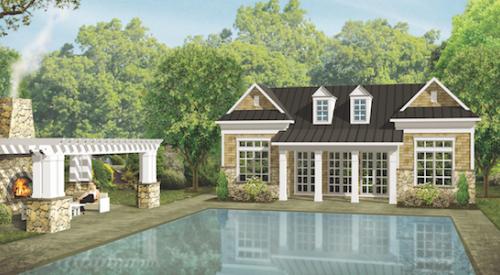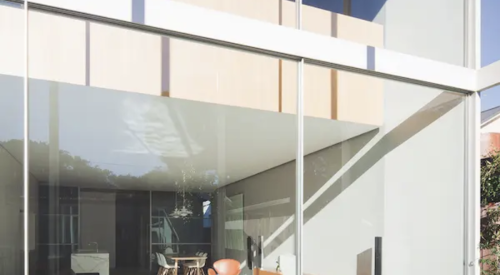During the recession, the desire for exterior living spaces caught on as a way to make new homes feel bigger. And the trend is continuing with the economic rebound, with many home builders allocating a portion of the budget to exteriors that make a home live as large as possible year round.
In recent years, how those outdoor spaces get outfitted has changed. Buyers seek to extend the same comforts and lifestyle they enjoy inside the home to the outdoors, from layout to lighting. Thanks to high-performing materials and smart technologies, builders are able to meet those needs.
Plain 10-foot-by-20-foot spaces are giving way to defined, function-driven areas for sitting and for eating, just like inside the home. Furniture is geared to comfort, with chairs and sofas covered in fabrics that are luxurious yet able to stand up to exterior conditions. “We’re really designing outdoor rooms for clients,” says Bob Hursthouse, owner of Hursthouse Landscape Architects & Contractors, in Bolingbrook, Ill. “We can design the space to fit the furniture and the amenities.” The advancement of materials is allowing for more refined looks, year-round use, and better performance.
High-Performance Decking Comes on Strong
Demand for high-performing, low-maintenance wood alternative decking is increasing again. In its latest report released in 2014, research firm The Freedonia Group predicts that U.S. demand for decking will rise 2.4 percent per year through 2018. Within the category, the report says, plastic and wood-plastic decking are growing the fastest, spurred in part by consumer demand for low maintenance and long life.
Capped decking represents more than half of the alternative-decking sector, providing an ideal combination of aesthetics and performance. “People want something that looks like real wood,” notes Steve Phillips, owner and president of Phillips Building & Contracting, in Callahan, Fla., who uses Azek-capped PVC for his new-home and remodeling projects. “[Companies are] coming out with more and more products that look like real wood, and they’re really nice,” Phillips says. Azek recently introduced two new colors to its Arbor collection of capped PVC decking, Brazilian Walnut and Mountain Redwood, reflecting the popular look of exotic hardwoods while offering scratch, split, mold, moisture, and insect resistance. In capped composites, TimberTech’s new Tropical collection, MoistureShield Pro, and Horizon from Fiberon each offer color options inspired by tropical hardwoods. Similarly, Trex added Havana Gold to the Premium Tropicals colors in its Transcend capped-composite decking line.
Composites also have expanded the use of built-in lighting. And small wireless sound systems can be integrated with deck railings and other built-in features, then remotely controlled.
Don’t count wood out entirely, though; it remains the dominant deck material. To keep up with demand for premium aesthetics, traditional lumber suppliers have been introducing higher-grade offerings made with heartwood or milled convex faces that shed water, notes Michael Beaudry, executive vice president of the North American Deck and Railing Association. Hardwoods such as ipe and mahogany also are in demand, he says.
Multiple tiers or the use of varied plank colors and textures are useful tools for designating task areas. “Now that consumers are seeing longevity, they’re getting more creative,” says Adam Zambanini, vice president of marketing for Trex, noting that he’s seeing increasing demand for built-in lighting, fireplaces and firepits, and creative staircases, including spiral options for smaller spaces. “[Homeowners are] spending more time out there, and they want more features on their deck.”
 Trex recently expanded its Transcend composite to other outdoor essentials, such as storage and pergolas. The material features a deep wood grain and vibrant colors.
Trex recently expanded its Transcend composite to other outdoor essentials, such as storage and pergolas. The material features a deep wood grain and vibrant colors.
Hardscaping Adds Texture
New paver styles provide hardscaping options that are attractive and water-wise, while increasing variety makes it possible to mix and match colors and textures. Pavers such as Pine Hall Brick’s StormPave and RainPave, or Belgard’s Aqua Roc and Eco Dublin help create clearly defined spaces and add visual interest while enabling rainwater to percolate into the soil and groundwater instead of running off into storm sewers. Some utilize voids between pavers, while others, such as KloroStone from KloroTech, are porous. Open-cell or plantable pavers, such as Grasscrete or those from Belgard or Soil Retention, allow grass to grow through, providing a stormwater-friendly surface that’s also unique and eye-catching.
 Sub-Zero's 24-inch outdoor refrigerator offers 5.7 cubic feet of storage for keeping fresh food nearby while coooking on the grill. It includes adjustable spill-proofe shelves, bright interior lighting, and a stainless stell door.
Sub-Zero's 24-inch outdoor refrigerator offers 5.7 cubic feet of storage for keeping fresh food nearby while coooking on the grill. It includes adjustable spill-proofe shelves, bright interior lighting, and a stainless stell door.
Lighting Is Evolving
Interior influences are driving outdoor lighting choices, too, says Jeff Dross, corporate director of education and industry trends at Kichler. “We’re finding demand for products that look like they belong inside the house,” he explains. “In our most recent catalog, we’ve released five pendant or chandelier-type products that look like interior fixtures but are made with materials to stand up to the exterior.”
David Peek, director of decorative product de-velopment at Progress Lighting, agrees. “Lighting fixtures that serve as bold and artistic statement pieces are on-trend,” he says. “With larger homes, there is a demand for oversized outdoor lighting options.” Kichler’s Halleron three-light pendants, for example, sport a spherical design and Victorian-inspired metalwork that would be just as at home in a foyer as they would be above an outdoor dining table. Cadence and Refuge from Progress include lantern styles in their selection, while Modern Forms, WAC, and Hinkley offer outdoor-rated luminaires that are sleek and architectural.
Along with styling, there’s an increase in the use of exterior and landscape lighting overall, driven by the improved flexibility afforded by LEDs and the desire for a more practical, attractive space. “We’re in our homes after dark a lot more than during the day, so to be able to appreciate the outdoors … is a critical thing for the design,” Hursthouse says. Homeowners don’t want to look at windows as black mirrors at nightfall, he adds; instead, they want to look out into their yard space.
Low-voltage landscape lighting is easy to install and can be strategically placed out of sight, such as shining down from trees, under deck rails and steps (such as WAC Lighting’s 2041 Circle LED Step Light), or tucked into the top of hardscape walls. LED tape designed for wet-location use is also growing in popularity, just as it is inside the house. Kichler, WAC, and Pegasus Lighting are some of the companies that offer outdoor-rated LED tape.
One goal when adding lighting to exterior locations is to avoid glare. “You don’t want 500-watt lighting shining onto the patio,” Dross says. “LED tape can be mounted under furniture, for example, and you have a glow underneath that radiates upward.” And, of course, LEDs also offer longer life spans and greater efficiency, with an immediate 75 to 80 percent reduction in operational costs, Dross points out.
 Lighting, like these pendants from Kichler, has kept pace with the demand for fixtures that offer indoor-quality looks and outdoor-rated durability and safety.
Lighting, like these pendants from Kichler, has kept pace with the demand for fixtures that offer indoor-quality looks and outdoor-rated durability and safety.
Outdoor Cooking Endures
As with indoor kitchens, outdoor cooking areas run the gamut from simple to deluxe. Manufacturers offer nearly any indoor appliance in a robust exterior version. How extravagant depends on your target market and budget.
“The most important aspect homeowners and homebuyers look for in their outdoor kitchen is a space that reflects their lifestyle,” says Brian Jones, director of product and channel marketing at Sub-Zero Group. Whether they’re diehard cooks who grill lavish meals or just want a steady supply of ice and cold drinks by the pool, the outdoor space should answer those preferences.
A grill is the first must-have. Builders offering outdoor kitchen upgrades may do best to provide several grill options, including higher-end models. “The challenge with the grill being the heart of the  outdoor kitchen is that if you hate that grill three years down the line, you will hate that outdoor kitchen,” says Russ Faulk, chief designer and head of product for Kalamazoo Outdoor Gourmet. And because there isn’t standard sizing for grills, changing out a built-in grill later can be difficult.
outdoor kitchen is that if you hate that grill three years down the line, you will hate that outdoor kitchen,” says Russ Faulk, chief designer and head of product for Kalamazoo Outdoor Gourmet. And because there isn’t standard sizing for grills, changing out a built-in grill later can be difficult.
Consider a prep sink to help homeowners avoid extra trips back into the house. If the budget is tight, portable units such as a grill island with a workstation on wheels can expand the work space without adding another several feet of built-in kitchen.
Interest in artisanal-quality cooking has been a solid trend for many years, and now it’s going outdoors, Faulk says. He points to the rising popularity of Kalamazoo’s Gaucho wood-fired grill, the continued popularity of its gas-fired pizza oven, and the resounding response to a new Smoker Cabinet it introduced at KBIS this year.
Outdoor-rated appliances offer excellent performance. Wolf’s new 54-inch gas grill, for example, has the same precise control and easy-to-use features as the company’s indoor offerings, including six individually controlled burners. Sub-Zero’s 24-inch undercounter refrigerator includes touch controls to manage temperature, and also has spill-proof shelves, bright lighting, and a clear storage bin. GE Appliances’ outdoor refrigerator offers adjustable temperature control, an LED temperature display, removable spill-proof glass shelves, and a full-extension beverage shelf with capacity for five wine bottles or 10 12-ounce cans. U-Line offers outdoor fridges and ice makers in 15- and 24-inch models to suit various configurations and budgets.
Mitch Slater, owner of Danver and Brown Jordan Outdoor Kitchens, observes the outdoor features trend in the increased demand for Danver’s painted outdoor cabinetry, which offers stainless steel construction to withstand the weather with powder-coated surfaces that look like wood or painted wood to carry over the interior look.
Keep Options In Mind
Even if the budget doesn’t allow for a complete build-out of the backyard, the outdoor space shouldn’t be an afterthought for builders because it can help sell a home. “When people drive around a planned community, how many of them go inside and look at the crown molding?” Beaudry asks. “They see the outside.”
Showcase exterior upgrades on your model homes—especially lighting—because buyers may drive by at night. “It’s your silent salesperson,” Dross notes. “It brings out the nuances of the structure. You can avoid lighting up things you don’t want to see, like the garbage shed, and instead light the trim or stonework.”
At a minimum, design outdoor space to help buyers plan for the future. Install a ledger board so that a deck can be attached safely and properly. Consider where decks might be built and avoid setting electrical boxes, hose bibs, and dryer vents in places where they will either be in the way or get trapped under a future deck. Or take it one step further and help them lay out a long-term plan. “[Landscape architects] are often not thought about until after the homeowner is home and they’re looking at a 10-by-12 chunk of concrete wondering what to do with it,” Hursthouse says. “We can be most successful for our clients when we’re involved before construction happens.”
Bringing it all together is the growing availability of technology. At the end of 2016, 50 percent of homes will have some sort of connectivity, and the outdoors are no different, Beaudry says. Being able to control lighting, sprinklers, and other outdoor technology using a touchpad or smartphone is becoming a key must-have, he says, appealing to that same desire that buyers have to enjoy all the comforts of indoors while savoring the great outdoors.
 In this outdoor living room by Hursthouse Landscape Architects & Contractors, defined outdoor living areas are designed around amenities that homeowners crave, such as a firepit for gathering.
In this outdoor living room by Hursthouse Landscape Architects & Contractors, defined outdoor living areas are designed around amenities that homeowners crave, such as a firepit for gathering.
 Danver's painted outdoor cabinets offer the best of both worlds: stainless steel construction to withstand the weather and powder-coated surfaces that look like wood or painted wood to carry over the interior look.
Danver's painted outdoor cabinets offer the best of both worlds: stainless steel construction to withstand the weather and powder-coated surfaces that look like wood or painted wood to carry over the interior look.
